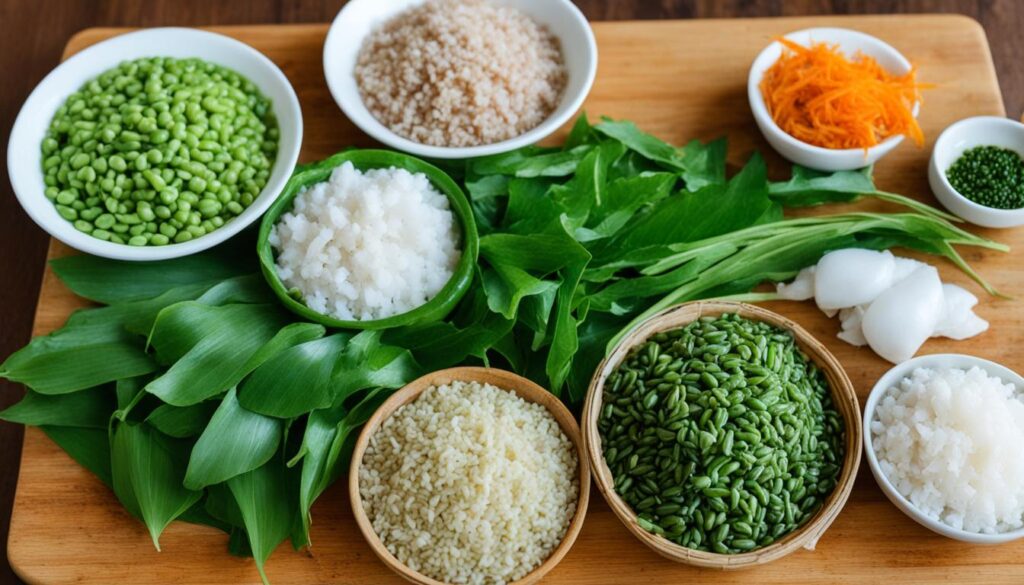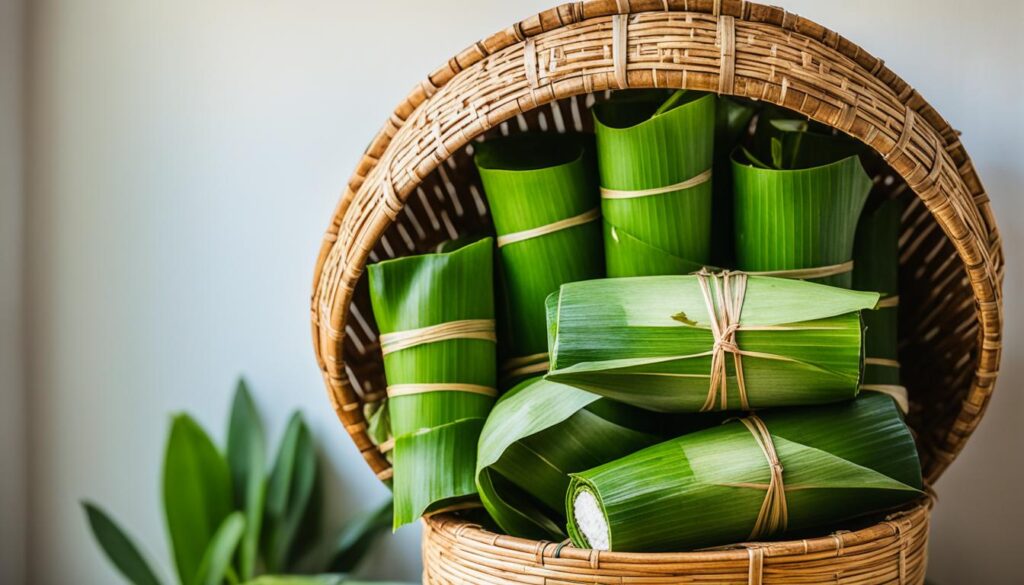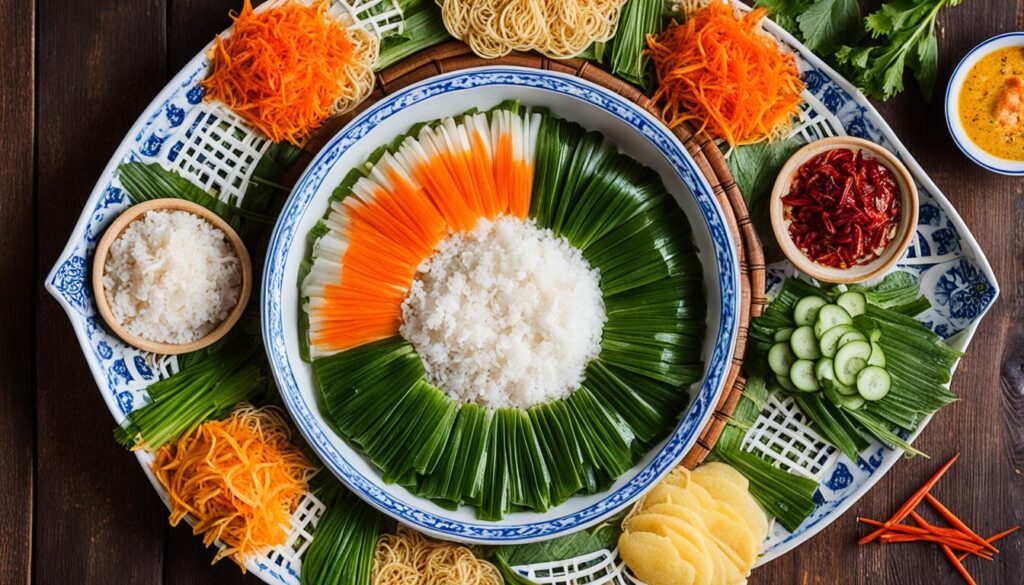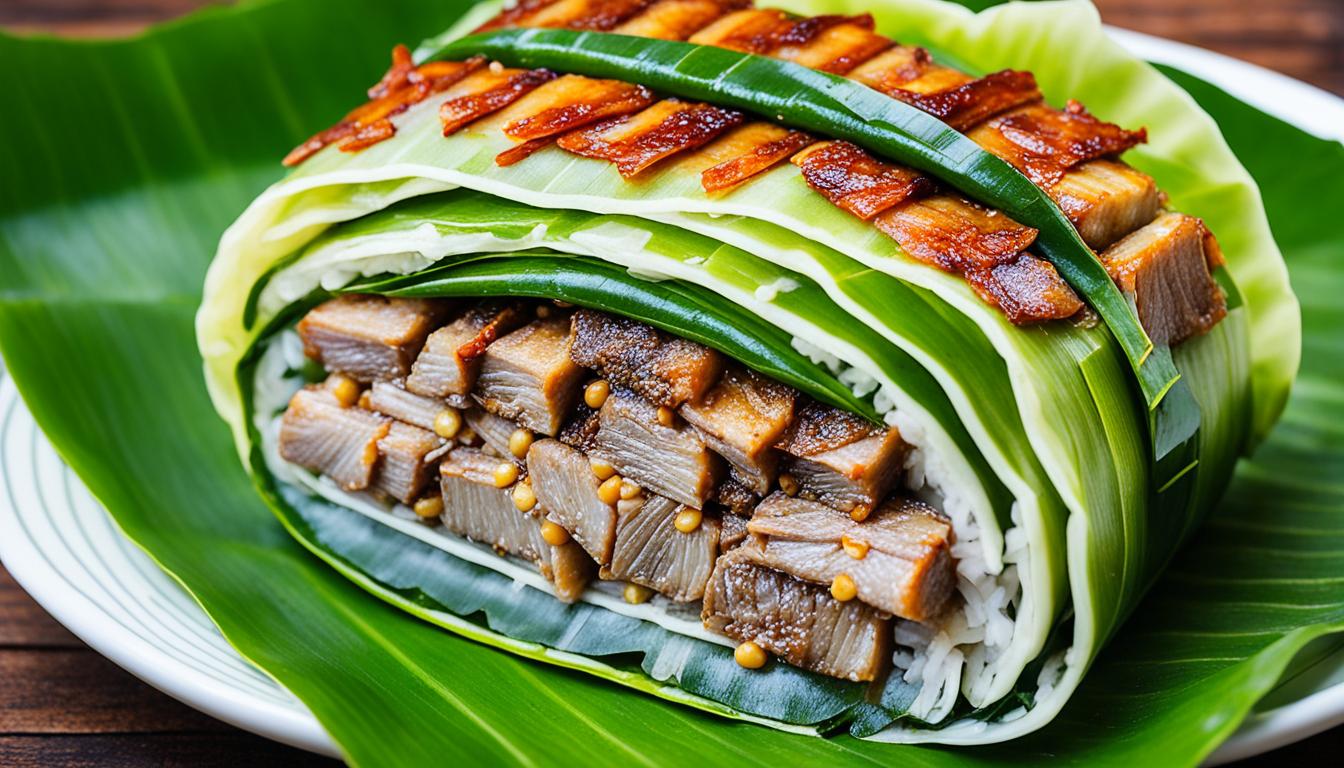Have you ever wondered how to make traditional Vietnamese rice cakes to celebrate Lunar New Year? With our step-by-step banh chung recipe, you can create authentic banh chung at home and bring the flavors and customs of Vietnamese culture to your table.
Key Takeaways:
- Learn how to make banh chung, a traditional Vietnamese rice cake.
- Celebrate Lunar New Year with a dish that symbolizes good luck and prosperity.
- Discover the key ingredients and kitchen equipment needed for banh chung.
- Follow our tips for making the best banh chung.
- Explore other Lunar New Year recipes to complete your festive menu.
What is Banh Chung?
Banh chung is a traditional Vietnamese rice cake that is typically made for Lunar New Year. It is a beloved dish that holds great cultural significance in Vietnam. The cake is made with sticky rice, mung beans, and pork, and wrapped in fragrant banana leaves. It is then boiled for hours until the flavors meld together and create a delicious blend of savory and earthy notes.
Banh chung is not just a simple rice cake; it represents the Earth itself. Its square shape symbolizes the Earth, while the layers of sticky rice and mung beans represent the essence of life and growth. The combination of ingredients is said to bring good luck and prosperity for the coming year, making it an essential dish for Lunar New Year celebrations.
“Banh chung is more than just a dish; it is a tradition that has been passed down through generations. Its preparation and enjoyment bring families together during this joyous time of year.”
During the Tet festival, which is the Vietnamese Lunar New Year celebration, banh chung is a staple on every family’s table. It is enjoyed alongside other traditional dishes, symbolizing unity, abundance, and family reunion. The process of making banh chung also serves as an opportunity for family members to come together, creating a bond that is as strong as the flavors of this treasured dish.
Kitchen Equipment For This Recipe
To make delicious banh chung, you’ll need to equip your kitchen with a few essential tools and equipment. These items will help you achieve the perfect texture and shape for your rice cakes.
Mixing Bowls
These versatile bowls are necessary for combining the ingredients and ensuring an even distribution of flavors.
Fine Mesh Sieve
The fine mesh sieve is vital for rinsing and draining the sticky rice and mung beans, removing any impurities.
Potato Masher
You’ll need a potato masher to puree the cooked mung beans, creating a smooth and creamy texture.
Square Molds
These molds give your banh chung the iconic shape and allow for easy slicing once they’re ready.
Large Pot
A large pot is essential for boiling the banh chung. Make sure it’s big enough to accommodate all the cakes.
Small Circle Wire Rack
A small circle wire rack is useful for keeping the banh chung elevated above the water while boiling, preventing them from sticking to the pot.
Banana Leaves
The banana leaves not only add an aromatic flavor but also serve as natural wrappers for the banh chung. They add a beautiful touch to the final presentation.
Tape and String
Finally, you’ll need tape and string to securely wrap the banh chung. This ensures that the ingredients are tightly packed and cooked evenly.
With this essential kitchen equipment, you’re well-prepared to create authentic, mouthwatering banh chung at home.
Ingredients
To make authentic banh chung, you will need the following ingredients:
- Sticky rice
- Mung beans
- Pork belly
- Salt
- Pepper
- Sugar
- Chicken bouillon powder
- Fish sauce
- Shallots
These ingredients are crucial for achieving the unique flavors and textures of banh chung. Sticky rice forms the base, while mung beans and pork belly add a delicious filling. Salt, pepper, and sugar season the dish, while chicken bouillon powder enhances the savory taste. Fish sauce and shallots provide additional depth of flavor.
Why These Ingredients Matter
The combination of sticky rice, mung beans, and pork belly creates a harmonious blend of flavors that is characteristic of banh chung. The sticky rice adds a chewy texture, while the mung beans bring a creamy and slightly nutty taste. The pork belly, with its savory and rich flavors, adds depth to the dish.
It’s important to use high-quality ingredients to achieve the best results. Fresh sticky rice ensures a sticky and cohesive cake, while good-quality mung beans and pork belly provide superior taste and texture. Seasonings such as salt, pepper, sugar, chicken bouillon powder, fish sauce, and shallots help enhance the overall flavor profile of the banh chung.
How To Make Banh Chung
To make banh chung, follow these step-by-step instructions:
- Soak the sticky rice and mung beans: Start by soaking the sticky rice and mung beans in water overnight. This softens the rice and beans, ensuring they cook evenly.
- Prepare the ingredients: While the rice and beans are soaking, prepare the other ingredients. Marinate the pork belly with salt, pepper, sugar, and fish sauce for extra flavor. Cook the mung beans until soft and easily mashable.
- Layer and wrap: Once everything is ready, it’s time to assemble the banh chung. Take a banana leaf and place a layer of soaked sticky rice on it, followed by a layer of mung beans and marinated pork belly. Repeat the layers until you run out of ingredients. Fold the banana leaf to encase the filling, and tie it securely with string.
- Cook the banh chung: Place the wrapped banh chung in a large pot and fill it with enough water to cover the cakes. Bring the water to a boil and let the banh chung simmer for several hours until cooked through. The long cooking time ensures that the flavors meld together and the ingredients fully cook.
Once the banh chung is cooked, remove it from the pot and let it cool before cutting into slices and serving. The result is a savory, sticky rice cake with layers of flavors from the pork and mung beans, wrapped in fragrant banana leaves.

Now that you know how to make banh chung, you can celebrate Lunar New Year with this traditional Vietnamese delicacy. The next section will provide additional tips and tricks for making the best banh chung.
Tips For The Best Banh Chung
When it comes to making the best banh chung, here are some helpful tips that will ensure your rice cakes turn out perfect every time:
- Soak the sticky rice and mung beans overnight: This step is crucial for achieving even cooking and a desirable texture in your banh chung.
- Use high-quality ingredients: To elevate the flavor of your banh chung, opt for fresh and high-quality sticky rice, mung beans, and pork belly.
- Wrap the banh chung tightly: To prevent any leaks during the cooking process, make sure to wrap the banh chung tightly with banana leaves. This will help preserve the flavors and maintain the integrity of the cake.
- Maintain a gentle boil: When cooking the banh chung, it is important to maintain a gentle boil. This will ensure even cooking throughout the cake and result in a tender and moist texture.
By following these tips, you’ll be able to create delicious and authentic banh chung that will impress your family and friends during Lunar New Year celebrations.
Storage Instructions
After making banh chung, you may have leftovers that you want to store for later. To ensure the longevity of your delicious rice cakes, follow these simple storage instructions:
- Cool Completely: Allow the banh chung to cool completely at room temperature.
- Tightly Wrap: Once cooled, tightly wrap each banh chung individually using plastic wrap or aluminum foil. This will help maintain freshness and prevent air exposure.
- Refrigerate: Place the wrapped banh chung in the refrigerator and store them for up to a week.
- Reheating: When you’re ready to enjoy your stored banh chung, simply reheat them in the microwave until heated through.
By following these storage instructions, you can savor the flavor of banh chung even after the Lunar New Year celebrations.

| Storage Step | Instructions |
|---|---|
| Cool Completely | Allow the banh chung to cool completely at room temperature. |
| Tightly Wrap | Once cooled, tightly wrap each banh chung individually using plastic wrap or aluminum foil. |
| Refrigerate | Place the wrapped banh chung in the refrigerator and store them for up to a week. |
| Reheating | When ready to enjoy, reheat the banh chung in the microwave until heated through. |
Additional Lunar New Year Recipes to Try
In addition to banh chung, there are many other delicious Lunar New Year recipes to try. These dishes will bring the flavors of Vietnamese holiday traditions to your table and help you celebrate the Lunar New Year, also known as Tet festival, in style. Here are a couple of popular options:
-
Thit Kho (Vietnamese Caramelized Braised Pork Ribs and Eggs)
Thit kho is a classic Lunar New Year dish that combines tender pork ribs and boiled eggs in a rich and flavorful caramel sauce. The dish is known for its sweet and savory taste, which perfectly complements banh chung.
-
Pineapple Tarts
Pineapple tarts are a delightful Lunar New Year treat that originated from the Chinese-Malaysian community and have become popular in Vietnam as well. These buttery cookies with a pineapple filling are often shaped like flowers or tarts and symbolize good luck and prosperity.
By exploring these Lunar New Year recipes, you can create a festive atmosphere and enjoy the flavors of Vietnamese holiday traditions. Whether you choose to make thit kho or pineapple tarts, these dishes will add a touch of authenticity to your Lunar New Year celebrations.
Conclusion
After exploring the detailed recipe for banh chung, we can conclude that this traditional Vietnamese rice cake is a cherished dish during the Lunar New Year celebration. Made with sticky rice, mung beans, and pork, and wrapped in banana leaves, banh chung holds both cultural and symbolic significance.
By following this recipe, you can create your own authentic banh chung at home and partake in the Lunar New Year festivities with this delicious and meaningful dish. The process of making banh chung may seem intricate, but the taste and satisfaction it brings are truly worth the effort.
“Banh chung is not just a food, it carries the essence of Vietnamese tradition and heritage. It symbolizes the connection between people, nature, and the blessings of the new year.” – Nguyen Van Quyet
Whether shared with family and friends or enjoyed as a personal treat, banh chung brings people together and serves as a reminder of the importance of cultural traditions. Its earthy flavors and hearty texture make it a delightful addition to any Lunar New Year feast.
So, this Lunar New Year, why not gather your loved ones and embark on the journey of making banh chung together? Discover the joy of preparing this time-honored delicacy and create lasting memories that celebrate both the past and the future.

Tips for Success:
- Soak the sticky rice and mung beans overnight for even cooking.
- Use high-quality ingredients to enhance the flavor of your banh chung.
- Wrap the banh chung tightly to prevent any leaks during the cooking process.
- Maintain a gentle boil while cooking the cakes to ensure even cooking.
Banh Chung Recipe – Quick Recap
- Soak sticky rice and mung beans overnight.
- Marinate pork belly and cook mung beans.
- Assemble banh chung by layering ingredients and wrapping in banana leaves.
- Boil the cakes for several hours until cooked through.
- Cool and serve.
With the comforting aroma of homemade banh chung, you can embrace the spirit of the Lunar New Year and savor the rich flavors that accompany this festive occasion. May this recipe bring you joy, prosperity, and a deeper appreciation for Vietnamese cuisine.
Resources
If you are looking for more information on banh chung and Vietnamese recipes, there are many resources available. Books like “Into the Vietnamese Kitchen” by Andrea Nguyen and online blogs like Lunch by Yen Ha can provide additional tips and variations on the banh chung recipe.
For a comprehensive collection of Vietnamese recipes, check out “The Pho Cookbook” by Andrea Nguyen. This cookbook not only features banh chung recipes but also guides you through the process of making other traditional Vietnamese dishes.
If you prefer online resources, websites like Viet World Kitchen and Vietnamese Foody offer a wide range of Vietnamese recipes, including different variations of banh chung. These websites often provide detailed step-by-step instructions, ingredient lists, and helpful tips for achieving the best results.
“Into the Vietnamese Kitchen is a must-have for anyone interested in Vietnamese cuisine. This book not only provides authentic banh chung recipes but also delves into the rich culinary traditions and stories behind the dishes.” – Chef Phan Nhu
Tips and Tricks for Perfect Banh Chung
- Soak the sticky rice and mung beans overnight for even cooking.
- Use high-quality ingredients for the best flavor.
- Wrap the banh chung tightly to prevent any leaks during cooking.
- Pay close attention to the boiling process to ensure even cooking throughout the cakes.
| Resource | Description |
|---|---|
| “Into the Vietnamese Kitchen” by Andrea Nguyen | A comprehensive cookbook with authentic banh chung recipes and other Vietnamese dishes. |
| Lunch by Yen Ha | An online blog featuring tips and variations on banh chung recipes. |
| The Pho Cookbook by Andrea Nguyen | A guide to making traditional Vietnamese dishes, including banh chung. |
| Viet World Kitchen | A website offering a variety of Vietnamese recipes, including banh chung. |
| Vietnamese Foody | An online resource with a collection of Vietnamese recipes, including banh chung variations. |
About the Author
Allow us to introduce ourselves. We are a team of professional copywriting journalists who share a common love for Vietnamese cuisine. With our deep-rooted passion and extensive knowledge, we have mastered the art of creating authentic Vietnamese dishes, including the traditional banh chung.
Driven by our desire to promote Vietnamese culture and share its gastronomic wonders, we are excited to present this banh chung recipe to our readers. Through our writing, we aim to transport you into the heart of Vietnamese cuisine, enabling you to experience the richness and flavors of this beloved culinary tradition.
Join us on this culinary journey as we explore the intricacies of banh chung and guide you through the step-by-step process of making this Lunar New Year delicacy. We are confident that you will find joy in recreating this traditional dish, steeped in history and symbolism, in the comfort of your own kitchen.
